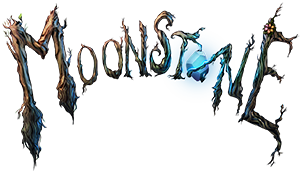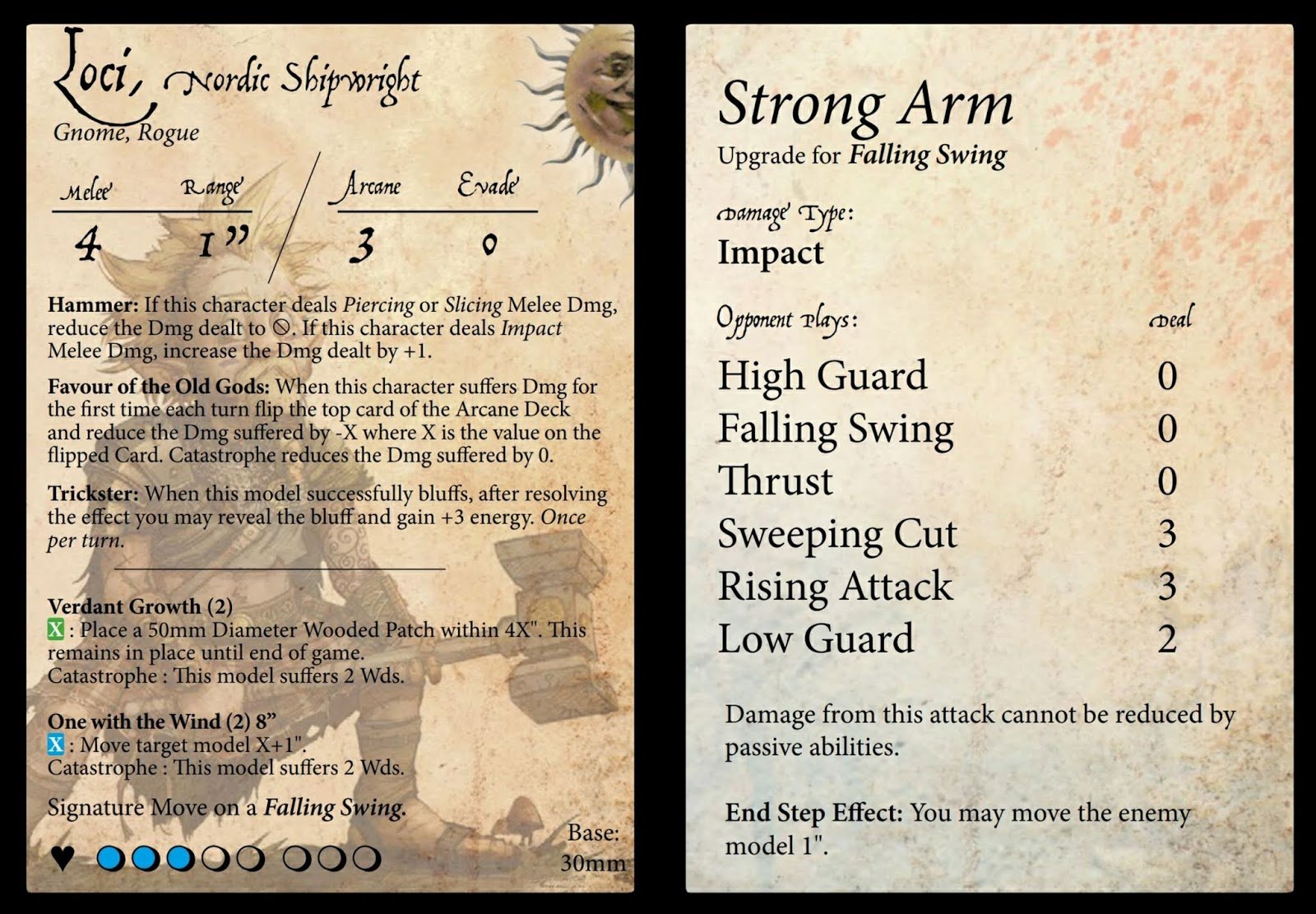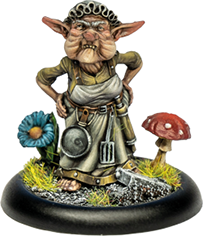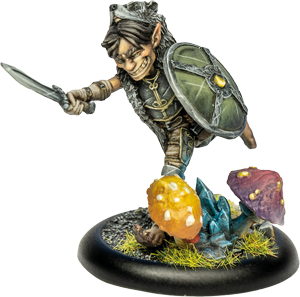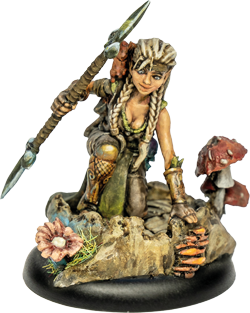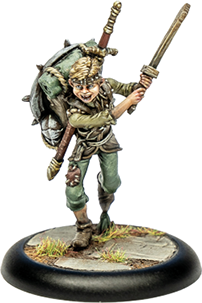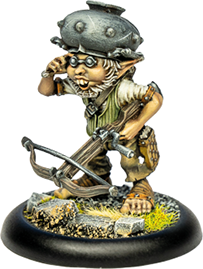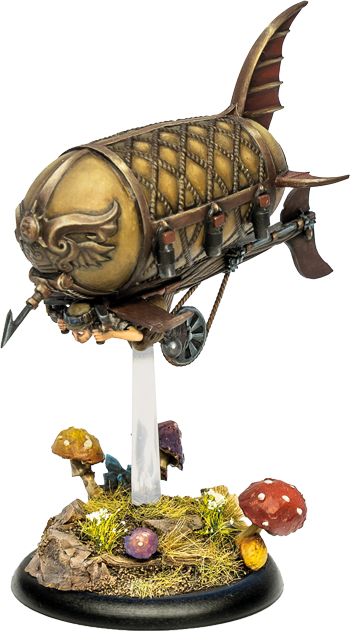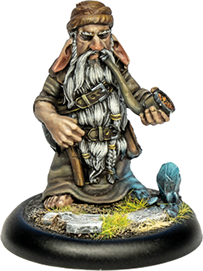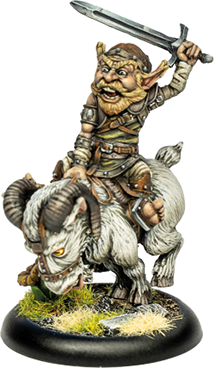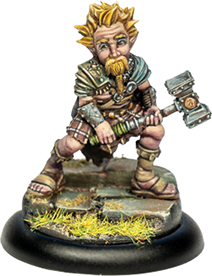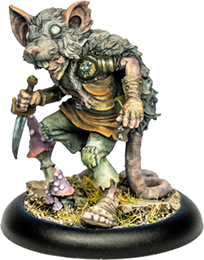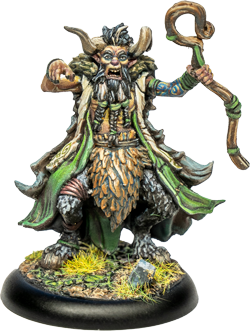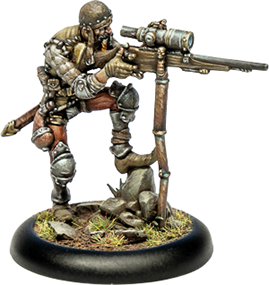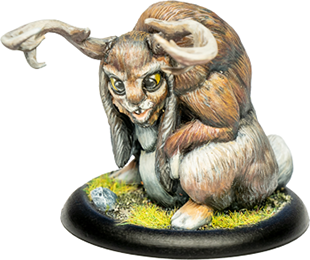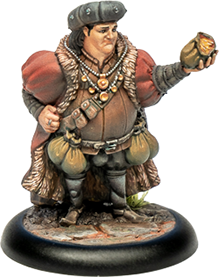Fun Unlimited with Commonwealth Gnomes*
Commonwealth is a straightforward faction with little to no tricks. Wrong! Gnomes are the perfect blend of jank and brute force. Not too complicated to learn, but learning all the subtle tricks takes time and practice. I can tell you for a fact, It is well worth the effort. So let's find out why gnomes are fun to play and how to make the most of each model.
Gnomish guest article written by Dhimesh Parmar.
Mama Gimble
Mama Gimble, alone a pitiful model with no real offensive presence. With gnomes, she is the bane of your opponent's existence. As Mama is a gnome, she has the typical gnome health and energy distribution: 6 health with all 3 of her energy at the lower end of her health. Mama is simply a support model for gnomes, with a passive 4" bubble that provides other friendly gnomes a +1 to melee, a +1 to arcane and -1 resistance from magical damage. So all gnomes like to stay around Mama for those sweet sweet buffs. Likewise, Mama also likes having gnomes around as all damage is reduced by the number of friendly gnomes within 3" of her (this includes herself as well). This makes Mama extremely hard to kill as for the majority of the game she can easily have 4+ damage resistance from all damage, if positioned correctly.
Apart from being a buffing model, she functions as a primary healer with two methods of healing: Her arcane ability and her active ability. Her arcane is a typical 2 energy cost action that heals a friendly model within 8” for X+1. Off her arcane of 6, this may seem like the best way of healing but spending 2 of your 3 energy on one action is very costly. The alternative, however, uses her active ability called mother’s love, which is truly the way to go. With a cost of 1, a range of 10” and healing for 2 without a flip, it is reliable, cost effective, has a longer range and has additional benefits of movement by pushing 2” towards the target model. It also pushes the target 2” towards her. So this can either be used to make up for Mama's awful movement speed with some positioning shenanigans or, in a pinch, an out of position model can be healed and come back to the safety of Mama. The only caveat to mother’s love is that it can only affect a gnome, which should not be a huge problem as who would bring Mama gimble in a non-gnome list? The last thing to consider about healing is the fact that Mama can use both mother’s love and her arcane healing in the same turn, for healing on one or more models if needed.
As touched on before Mama is a model with the slow trait, meaning she can only jog 2". Mother's love is the primary method of moving Mama as it essentially moves Mama 2" for 1 energy. The other movement option Mama has is her signature. It allows Mama to change places with a friendly model within 4". In a pinch, this can get Mama out of threat ranges of an opponent's model and get a more suitable model into combat. However this is best used as a last resort, as a melee stat of 2 is bad and 4 on the attack just feels mediocre, but in a pinch can save Mama from danger.
Finally comes the best ability on Mama’s card: Mother’s wrath. This one ability can change the course of the game. By spending a single energy on Mama, all other gnomes within 3” gain an energy and all enemy models suffer 2 wounds. This ability can only be triggered once per game, as it would be far too good otherwise. Seeing as many gnomes are balanced by the amount of energy they have limiting the number of actions that can be taken. At the end of this article, I will exactly describe how the turn Mama uses this ability shapes the entire game, but for that, I’ll need to describe the other gnomes first.
Mama is a solid model that thrives in any gnome list, being the most important model in the troupe. Her strengths come from being a very tough model to kill and the huge potential of healing on the turn she activates. Her weakness is positioning. If she is away from her gnomes, she becomes one of the easiest models to deal with (2 melee, melee range of 1" and 6 wounds). So be wary of models like Boom Boom McBoom and Kaufman. Also, models that negate abilities when they attack like the Vicious Midget’s and El Capitano’s signature attacks that ignore passive damage reduction which can kill Mama so be wary of those too. Note: Mama is a great holder of moonstones as she is already slow, so movement being impeded is not an issue, and having huge damage resistance means she is extremely hard to kill.
Morris
Morris the miner, the name that fits and says what this model is all about. He is arguably the best model to dig up moonstones in the game as he has the unique ability to harvest any stone for 1 energy. Along with that, he has 8 wounds and the ability to heal 2 wounds at the start of his turn meaning once he has the stone it can be difficult to take them off him. He only has 2 energy, which at times can feel like very little, but they are at the end of his health so it is unlikely that you'll have fewer energy at the start of the round.
Apart from his mining, Morris has a respectable range attack. Though it may cost 2 energy, the main goal of the attack is not really to damage the target but is to apply slow to them. This means a valuable target can't run away, or a scary melee attacker can't get into range. Also, it deals wounds as opposed to damage so there is no passive damage reduction to worry about, which is quite handy. He also has a 0 cost, once per turn ability that moves a target model 2” away. This can be used to either move a model up the board or away from harm. It can also be used on enemy models, but being limited to a 1” range, which means it’s best used defensively to attempt to move dangerous melee models away.
Morris is a strange one when it comes to melee. He has a lackluster melee stat of 3, 4 if Mama is around. He has no damage reduction and deals no damage on a slicing attack. But, he does deal +2 damage on an impact attack. Now, rising attack and falling swing can both be impact, and if you predict correctly, will swing the melee combat in your favour. Also, his signature, on the falling swing, ignores passives so it would deal a minimum damage of 4 on the target, except against a high guard. The only attack that has to be slicing is sweeping cut. Now if you can predict the thrust, this can allow you to deal massive damage with either the rising or falling on the follow-up attack, but an incorrect prediction is very costly. Due to his poor melee stat, melee is more dependent on the luck of the draw than most, including myself, would be comfortable with. So it is ill-advised.
Overall, Morris is a niche model whose selection is really dependent on the moonstone drop. I can see two reasons to have Morris. The first is if there are many high depth stones in your deployment. Morris can go and scoop them up. The second is if there are more stones on your side of the deployment and you want to slow the enemy so you can quickly pick them up. This is riskier, but denying your opponent the opportunity to get near the stones can entirely win you a game. The biggest problem with Morris is that he specialises in a very niche task, which makes his selection difficult for teams and even harder in a tournament, but he has the potential to do well.
Edit- since the 2023 errata Morris is now immune to teh ‘slow’ condition from Moonstones, so he has become a much better objective runnerthan before!
Gradock
Gradock is a gnome, militia model (yes the militia is important for later). Gradock can be summed up as truly rage-inducing to play against. Similar to Morris, Gradock has 8 wounds and 2 energy at the bottom of his health. He also recovers 2 wounds at the start of each of his activations. His passive auras are a part of why he can be devastating.
Firstly, if a model within 2" of Gradock (friendly or foe) is targeted by an arcane ability by the enemy, the card played must be revealed. So, it's a 2" bubble of no lying. This means there will never be a recasting if you guess incorrectly. Models with trickster can't get extra energy. The intrigue of the arcane guessing game is non-existent when the opponent casts. The second essentially flips the script. It's a 4" aura, where friendly models may ignore catastrophe effects. This means the only consequence of lying is that the arcane ability will not go off. So this is where the mind games begin. Calling a lie incorrectly means the ability will get recast (no downsides so why not) but not calling it means that any card can be played down. It's a win-win situation where the opponent really needs to think carefully and where overthinking can be devastating.
If you thought that was all the awful things Gradock had, think again, or more accurately forget about it. Forgetfulness will make opponents rage as key abilities are unusable for a whole round. It costs 1 energy, so it can be used twice a turn, and without any kind of flip, an active or arcane ability is removed from a character. Limited to only 8" (which is still quite far) this ability can stop enemies from shooting, healing, reloading, etc. The list is endless and so it the havoc created when this ability is used correctly.
Gradock has a ranged arcane attack that may seem lackluster but it does have its uses. Off an arcane of 2, 3 is Mama is around, it deals X damage but has a fantastic range of 14”. It also ignores evade and cover, which means this is one of the few attacks that can target evasive models (like faeries and Natty). It may cost 2 energy, which is expensive but can also be that final blow to kill a pesky model running away with all the stones.
Finally, we have Gradock in melee. He’s got a melee of 4, which is respectable for gnomes. Gradock has no damage modifiers and his signature will probably be used more for the movement, rather than the damage. Basically, he’s not a model for melee combat but he is also not entirely helpless if it happens.
Overall, Gradock is basically used for his auras and the ability to make enemy models forget key abilities. He counters faeries and other models that rely heavily on a single arcane attack of active ability. He also helps gnomes with ranged attacks as having the ability to lie without the fear of the catastrophe is very strong and can be very annoying for the opponent.
Young Jack
So Jack on the surface seems like your basic melee model, sporting good melee damage modifiers and a shield that reduces all damage by 1. But if you scratch the surface, he is so much scarier and should be respected when played against. So Jack is a gnome, noble and militia model. Gnome means that Mama’s auras affect him while being a noble means that Eric the squire and bodyguard models also have a use alongside him. We’ll get to why militia is the reason he is so good. Jack has 7 wounds and 3 energy at the bottom of his health, which is decent for gnomes.
So Jack has some of the following incredible abilities that allow him to function well. First, let's talk about magical brew. It’s an arcane ability that costs 1 energy, where a blue will heal you and a pink will provide you with energy. Off his arcane of 2, 3 with Mama, this may seem unreliable but this is where his active ability comes into play. Lucky is one of the few abilities that let you look at the arcane deck. It lets you see the top 5 cards of the deck and you can place any number of them at the top and bottom of the deck. This can be used in conjunction with magical brew, which can be used to set up for an attack next turn by a friendly model or stop an attack from an enemy model. It is versatile and only cost 1, which is worth the cost. Also, it is not once per turn, so Jack can use it to place a blue card on the top of the deck, heal using magical brew and use Lucky again to set up for the next turn.
So Jack is primarily a melee model. Having a melee of 4, may seem low but can be increased by Mama and Eric’s auras (both being 4”). His true weakness is his 1” range, so you really need to move Jack so that he is base to base with his target, so they can’t step away. His slicing damage is increased by +2, and piercing is increased by +1, so all but his signature is modified. His signature is on a low guard and deals respectable damage to all attacks apart from thrust and has the added bonus of moving the target 2” directly away from Jack. Now, why is Jack annoying to deal with? Well, all his strength comes from his ability to increase his melee to silly levels. With Mama and Eric, he can have a melee of 7, 9 on the attack and being a militia means it can be boosted even further. This heavily skews the melee combat in favour of Young Jack. Also the merits of Jack’s signature cannot be unstated. Turning a guard into a damaging move is disgusting, especially when you consider the following: If a rising attack is played, Jack can counter and follow up. If a falling swing is played, Jack can turn it into damage, still making the card effective. It’s one of the few attacks that can damage though both guards as well. The ability to move an enemy model 2” after the attack (multiplied by the number of low guards played) means you can shove a model away from a moonstone you want to harvest or move a dangerous melee model away from the rest of the team. The only card that counters this signature is a thrust, which both players should be very wary of. Mostly due to the fact that a sweeping cut off Jack hurts as it gets +2 slicing damage and is good against thrusts, rising attacks, and falling swings, but there will be damage dealt to Jack.
Overall, Jack is an incredible model that should be considered in almost all gnome, militia and even noble compositions. His melee capabilities are vasts and are only limited by his 1” range. Magical brew is a useful ability, but without support, it can be chaotic and unpredictable. Lucky is a great ability with a near unlimited amount of uses and ways to influence the game. Jack also has one of the best armours as it blocks damage from all sources and is very good at keeping him alive.
Billy
Gnomes are slow, right? Well take a quick look at Billy and this misconception will be shattered. Billy is a typical gnome with 8 wounds and 3 energy on the lower end of his health. He has 4 melee and 4 arcane, all very standard for a gnome, but the true strength of Billy comes from his abilities. Billy is the only gnome (so far) that has an evade stat of -1, which is a nice touch to show his speedy nature. Apart from being a gnome, Billy is a militia and also has the animal trait. The militia is a great trait to have as a gnome and animal means that he may see some use in commonwealth animal/faun lists in the future.
So Billy has an active ability and an arcane ability. His active ability, ramming speed, costs 3 energy and allows Billy to move 6” towards an enemy model. If base contact is made, the target is dealt X+1 impact damage and the target is moved X” away. So this ability has many factors to consider. Now, this essentially has a 10” threat range to engage/damage an enemy model, which is crazy. This can also be used to push enemies away from moonstones or possibly off the board (which is incredibly funny when it works). However, the pushing on this ability is entirely dependent on a blind flip of the arcane (unless lucky is used prior). There’s a 1/7 chance of catastrophe occurring but this is usually a risk worth taking, as this ability is mostly used as a hail-mary or some ludicrous half-baked mad plan. The arcane ability is something that should be used often as it is one of the best movement techs for the gnomes. Off Billy’s arcane of 4, 5 with Mama, and going off two colours, it allows Billy to move 2X”. More often than not, this means Billy is moving around 4”, or more if you find a 3 or your opponent calls a bluff incorrectly. This allows Billy to move very quickly, even if he is carrying a moonstone. This is where Billy truly shines. Having the ability to move on turn 1, such that he can pick up a low cost stone, then on turn 2, he can run away holding the stone. If the moonstone gods bless the stone scatter, Billy can sometimes have the potential to pick up 2 or 3 stones before the opponent can react, and his evade means that shooting him is not that reliable.
In melee, Billy is decent. He deals +1 damage on slicing and takes -1 damage on slicing due to his armour. This seems decent but Billy’s true strength comes from his signature. On the falling swing, it becomes an attack where each critical hit deals an extra damage meaning if you play 2 cards it deals an extra damage and if you play 3 you deal two extra damage. Along with its very uniform damage distribution and the fact that it’s also slicing damage makes it an extremely reliable attack. Also, the end step really highlights why it's a great defensive attack. Being able to move the enemy model that initiated the melee up to 3” away is great. Also being a militia means his melee can be increased, also helping with his survivability.
Overall, Billy is possibly the most fun gnome to play with, as he whizzes around the board collecting all the stones and being a general nuisance to deal with. Probably my favourite gnome that is mostly dependent on the stone drop at the start, in my opinion. With a plan, Billy will shine. Without a plan, Billy is versatile and provides options. What more do you want from a model?
Gnomish Airship
The airship is one of two dedicated ranged damage dealers in the gnomes. Having no melee stats and the unique ability of avoiding engagement. It also cannot harvest moonstones or get any benefits of cover. The airship has 8 wounds, 3 energy at the bottom of its health and an evade of +1. Also, it has no damage resistance so it's a model that's easy to hit with arcane abilities. Even with all these negatives, it is still a great model and fulfills the unique niche of range very well. Sporting an arcane of 3, 4 if, near Mama, it looks underwhelming. But if you analyse its arcane abilities you’ll understand why. Especially when you see that the airship can “fly” over obstacles that would impede other models, so it can easily maneuver to a favourable location to fire. It also helps that the airship has the militia keyword as well.
So the airship has 2 arcane abilities. Firstly, there is the main ranged attack of the airship. It costs 1 energy to fire then a further 2 to reload. With a range of 10” and X+2 piercing damage, the ability is very consistent with a 3/4/5 damage profile. The attack comes with the added bonus of pushing the target enemy 1” after a successful attack and the target cannot benefit from cover. Though the overall cost may seem high, the ability to fire as long as you can draw a line of sight within 10” is insane. If the airship wants to shoot at a target, most times the airship will have a viable shot. Also, the cost of getting caught bluffing is very high. If the airship is not near Graddock, getting catastrophe is crippling as it ruins the main form of damage the airship can deal. The second arcane ability is more situational but infinitely more fun when used. It’s a 2 energy cost ability called dropping bombs. Unsurprisingly it’s an area attack affecting models with 2” of the airship (friend or foe) dealing X+1 magical damage and pushing the models X” directly away. This ability is great for damaging pesky, high evade models as it doesn’t target a model. Magical damage is hardly resisted so that is a huge bonus, especially good against high armour melee models. The only negative is that calling a bluff against the bombs is a safe bet, as long as a 2 or higher is played, the follow-up attack will not have targets to bomb due to the initial attack pushing them out of range. This is why base contacting key targets is recommended so that on a 1 or 2, they can still be in range of a follow-up bomb.
Basically, bluffing this action is not advised as the initial attack may push the target model out of range from the follow-up attack. So the opponent essentially loses nothing by calling the bluff as no follow-up attack could be made. The catastrophe for the airship is suffering 4 wounds, which is steep, so lying is not recommended.
Overall, the airship is a unique model as it forces the opponent to bring range to deal with it. It is also very susceptible to range damage but the fear of the airship’s ranged damage is a huge factor why it is generally successful. If played correctly, the airship can tear the enemy troupe apart by shooting and killing key models, but mispositioning or getting caught lying can spell absolute doom for the airship. Basically, it’s an all or nothing model with great potential and is worth the risk to bring.
Quarrel
Quarrel is the other dedicated ranged model in gnomes, but he offers so much more than just range. Like most gnomes, he has 8 wounds and 3 energy at the bottom of his health. He also has a mediocre melee stat of 3, with a range of 1” and an arcane of 3 as well. He also has the unfortunate joy of starting with slow, so movement is not one of his strengths. Then why is he possibly the second most important gnome available in the game (after Mama obviously)?
Well, Quarrel has a typical ranged arcane attack and a unique active ability. The arcane attack is a 1 energy cost, 14” crossbow with a simple 2X piercing damage profile. This gives him a 2/4/6 damage track which is incredible on the higher end but the lower end leaves something to be desired for a dedicated ranged attacker. The attack also pushes the target 1” away after a successful hit which is a nice addition. It does cost 2 energy to reload and you cannot reload if Quarrel is engaged. Crossbow has an outrageous range of 14”, so even though Quarrel is slow, he has the ability to shoot models from the start of the game (the minimum distance between deployments is 16”). The biggest obstacle for shooting at long ranges is positioning, especially your own models. Remember, the crossbow does not ignore cover, so if you can draw a line from each base that is obstructed, the target gains cover. If you position poorly, shots will be obstructed probably by your own models, so you’ll give the target cover from the shot, which is undesirable. On the flip-side, if the opponent poorly positions a model, Quarrel can easily take a shot to potentially deal massive damage. Quarrel’s other ability is why he is so dangerous. Brothers in arms is a 1 cost ability that targets a militia model within 4” and gives them +2 melee and +1 arcane. That would be enough but the target can also spend an energy and affect Quarrel. Enough? Of course not, as this is not limited to once per turn it can affect the same target multiple times, so it can also affect Quarrel multiple times as well. This in conjunction with mother’s wrath and the models that this ability can affect are the reasons why Quarrel is dangerous and is a top priority for any opponent to kill as soon as possible. Near the end of the article, I have explained in depth how to properly abuse this ability, as it is too much to write here.
Melee is truly where Quarrel lacks, only having a melee of 3 is woeful and increasing it to 4 when around Mama will help, but not much. Quarrel has no damage resistance and only increases slicing damage by 1. His signature suits him as it’s on a high guard, reduces damage suffered by 1 per copy and moves him 2” per copy. Getting multiple high guards is only achievable on the attack, which already implies things are not going well. But if luck smiles upon Quarrel, he can move faster than he’d ever imagined.
Overall, Quarrel is a great ranged attacker as he sports a 14” with the potential of great damage on the mid to higher end. Predictably, Quarrel has poor melee stats and there is nothing special about them. However, in my opinion, if his card was blank and only had brothers in arms, he would be an auto-pick in militia comps. Having a base of 3 stacks of brothers of arms, on the surface, on certain models is scary. See the brothers in arms section to see how it can be abused along with the other militia models and the correct support.
Loci
Loci is a gnome and a rogue. He has 8 wounds and 3 energy at the bottom of his health track. With a melee of 4, melee range of 1" and an arcane of 3, Loci seems to be a typical gnome. Loci increases impact damage by 1, but cannot deal piercing or slicing damage. This vastly limits the offensive presence of Loci in melee. His defensive passive allows him to reduce the first instance of damage dealt to him by X. This can situationally be very helpful, but due to its inherent inconsistency, you can't rely on it to protect Loci all the time. It also only works once per round, which severely hampers the survivability of Loci. He is also a model with trickster (as his name would already suggest). This means that if he successfully bluffs on his activation, he gains an extra 3 energy to spend. This essentially means that he can be a 6 energy model, but it shouldn’t be relied on all the time. This is best used as a terror tactic and play mind games with the opponent, making them incorrectly call bluffs so that Loci can recast an ability for free most of the time and once in a while bluff, just to see the face of the opponent drop in awe of your risky play.
Loci has some very useful arcane abilities that can help the team. First is verdant growth. This costs 2 energy and allows Loci to place a wooded patch within 4X”. This patch remains on the board till the end of the game. This patch can have a few different applications. It can simply be used to provide cover as it is a 50mm base, which is very handy against ranged heavy teams. It can also be used to block paths for the opponent, either stopping them from coming towards you or some stones, but also can stop models from escaping. This can be very good as it can isolate weaker models or those carrying stones from the rest of their team. But beware, faeries are still able to freely traverse over these patches as they are essentially forests in design. The other for these patches is to provide Joanna a method of using her arcane ability to deal damage to opposing models. So a niche but versatile ability. Loci’s other arcane ability is a 2 cost ability called one with the wind. This allows him to move a target model, friend or foe, X+1”. This allows Loci to move models around outside their activation, which is a great boon at times. As gnomes generally struggle to rush towards stones in the middle of the opposing deployment, this can be used to move models towards the stones, in an attempt to harvest them or stop the opponent from having essentially having a free stone. The other is that if a model has a stone or is getting buffs from other nearby models, this can be used to drag them away, in an attempt to try and deal with that model. This ability is generally why Loci is selected, especially if you are the player with initiative (so didn’t choose table edge) and the stones are slightly skewed on one side of the board.
As stated previously, Loci does struggle a bit with melee as he can only deal impact damage. This limits the options of cards he can play as both thrust and sweeping cut don’t have an impact damage option. Luckily, Loci has a strong signature attack on a falling swing. It deals at least 0 damage to all cards played, which is always increased by 1 due to his weapon. It also ignores passive damage reduction, so all damage dealt will reduce the health of the opposing player. Its end step effect is optional as you may move the enemy model 1” (per falling swing). This is great as it can be used defensively, or used to move models away from stones. It is a move so it can be used to reposition the opposing model away from their team and in the middle of the gnome scrum, which will severely reduce the effectiveness of that model in melee. Also, the signature attack will either deal 1 damage or 3+ damage, so prediction is everything. So, in melee, Loci can do great work but is also not his original purpose on the team.
Overall, I believe that Loci is a hidden gem in the gnomes. The ability to move the gnomes faster is alone enough to include him in teams, especially if you have the initiative. Also, the mind games with trickster and harassing the opponent with wooded patches is quite fun. So a model that should always be considered, even though he doesn’t have a ranged attack or particularly shine in melee.
Muridae
Muridae is the only commonwealth gnome, that is also a part of the dominion faction as well. He also has the rogue trait, which itself is unimpressive but allows him to interact with a wider pool of models than just other gnomes. Muridae has 8 wounds and similar to other gnomes he has all 3 of his energy on the lower end of his health track. He has a melee stat of 4 and a range of 1". He also has no arcane stat as he has no arcane abilities. He does, however, have a great aura which gives all friendly rogues, within 6", a +1 in their arcane stat. He also has a pelt that deduces magical and slicing damage by -1 and a dagger that increases piercing damage by +1. His aura lets him synergise well in rogue teams (both commonwealth and dominion ones). He is also one of the few characters that reduces magical damage, which once you understand his role, makes a lot of sense for this character.
So what is Muridae all about? Stealing stones. His abilities and even his signature are all about this one job he should be doing. He sports a variety of abilities which allow him to maneuver around models and get away with his theft. His main ability is obviously his robbery. This costs 2 energy and allows Muridae to take a moonstone off that model (friendly or foe). It is limited to a range of 1" and the target must have fewer wounds remaining than Muridae. Even so, this ability is integral to the role he plays and helps his team deal with certain threats. Models such as the revenant and some faeries can take stones and there are few ways to get the stone off them. Robbery offers a method of taking stones without killing the model holding it. The revenant can't die and killing a faerie, in melee or at range, is difficult, luck-dependant and can be energy inefficient. So Muridae is a very important character. His other abilities include sneaking, squeaking and sewer rat, which all cost 1 energy each. Sneaking gives Muridae an evade stat of -2, which in conjunction with cover, makes him an evasive, undesirable target to attack at range. Especially considering that his pelt is designed to resist magical damage (which is the damage type primary used by faeries at range). This is his primary method of not dying before he can get close enough to use his next ability.
So, have you wondered how Muridae could actually get within 1" of models to use robbery yet? For a lesser model, this would mean you would have to touch bases with the target model with the stone. But not Muridae, he has a trump card called squeaking. Squeaking targets an enemy within 6" and moves them 1". It sounds simple but then the opposing player can’t use a reaction step in response to this, which is huge. This gives Muridae some options to deal with some particularly annoying scenarios. The first is simply trying to get in range to use robbery. So Muridae can jog within 1”, then use squeaking if the opposing model tried to reaction step away. The second is conversely when Muridae wants to escape from engagement. If he has a stone but is engaged, he can’t jog away. The opponent can reaction step back into engagement if he tries to step away. Using squeaking to move the model away and since they would ordinarily reaction after that, escape becomes a feasible task. Other uses include moving an enemy to engage another model, moving an enemy so that harvesting a stone is possible and using the enemy as cover to block or provide cover from a ranged attack. Muridae’s final ability, sewer rat, is a means of escape once he has stolen as many stones as possible. It allows him to essentially remove himself from the board for a turn if he is in a building, then return back the following turn in any building. This has two uses, running away or running in, as it can be used early in the game to place Muridae in a favourable location. It is once per game, so use it wisely to make the most of Muridae.
Muridae in melee is an interesting one, with a melee of 4 and 1” range, he can feel lackluster seeing as it is his only method of dealing damage. His signature is on a slicing cut, which upgrades to hamstring. This attack can deal damage regardless of what the opponent plays, even the 0 damage on the low guard can be increased. If more than 1 wound is dealt, the target also gains slow and can’t take steps or reaction steps for the rest of the turn. Two things to note here, first, it’s slicing damage, so he cannot increase the damage of hamstring himself. The second being you have to wound the enemy, so it has to deal more damage than the damage reduction of the enemy and some signatures entirely reduce all damage dealt (the faerie ones specifically). If you can deal a successful hamstring attack, it can cripple and opponents plan and make the target vulnerable for theft or a follow-up attack by any model.
Overall, Muridae has a niche role in the gnomes and in rogue lists. He shines in harassing the opposing player and making them work around what he can do. He is hard to shoot, hard to run away from, difficult to chase and not to forget that he will steal stones. A great pick in certain games for both commonwealth and roguish dominion teams.
Joanna
Joanna is a premier melee model in the gnomes with a few other tips and tricks to keep her interesting. Similar to other gnomes, she has 7 wounds and 3 energy at the lower end of her health. Boasting a melee stat of 5 and a range of 2", Joanna is the best unboosted melee gnome. Since she is a gnome and a noble, both Mama and Eric can increase the melee to 8 and 10 on the attack, which is very respectable. She also has an arcane of 3, which is the average for most gnomes, so it isn't too bad. Joanna also has great damage resistance as all damage is reduced by 1 for each friendly gnome or animal within 4" (max 3). So if positioned well, she can have 3 damage reduction from all sources for the majority of the game which is crazy good. Joanna also increases slicing damage by +1, which for a dedicated melee model would be lackluster, but Joanna is so much more than a typical melee bruiser.
She has a couple of arcane abilities, that allow her to have some options during her activation. First is her pixie-elf elixir. This is a 2 cost, once a turn ability that allows Joanna to generate more energy on her turn. Providing X+1 energy, you would break even on a flip of 1 and have again if you get anything higher. The problem here is her middling arcane stat. With 3 arcane, 4 if Mama around, and only triggering on a single colour, the odds of fluffing the flip and losing 2 energy is around 25% (with an arcane of 4). Also, the catastrophe is quite bad as the 3 wounds go through her damage reduction. So is it worth it? Sometimes, depending on the player. If gambling is your playstyle, go for it. If not, then the energy can be used for reaction steps or for using the other arcane of Joanna. The actual chance of getting more energy is just a tad less than 50%, so be aware of that. Joanna’s other arcane is a 2 cost ranged attack, with a ludicrous range of 18”, dealing X magical damage and ignores cover. The only caveat is that the target must be within 3” of a forest or wooded patch. This is a great way to deal chip damage to targets making them susceptible to being killed by a strong ranged model. It's also an ability that an opponent either forgets about, or a moonstone drop position means that they have to move within a forest range to try and collect the stone.
Now, Joanna's melee. A melee stat of 5 seems good, being able to get to 10 on the attack, with the correct support models. She is also unique as she is the only gnome with a melee range greater than 1", elevating her combat skills further. The only lackluster part of her melee kit is that her weapon only increases slicing damage by +1, which compared to other melee combatants (especially in commonwealth), is poor. Joanna's special is on a sweeping cut with many benefits. It's an attack that can damage the opponent regardless of the card played as it deals at least 0 slicing damage, which is innately increased by 1 due to her weapon. Also, the end step effect on the attack is situational, but an easy one to set up. It deals 2 slicing damage to all models within 2" that were not part of the combat, friend and foe alike. It doesn't count as melee damage so it is not modified by her weapon. Also, remember this is for each slicing attack played, so a maximum of 6 damage can be dealt to all models within 2". This, along with her melee of 2", allows Joanna to engage multiple enemies while limiting how many are engaging her, and deal silly splash damage to all the models. The downsides of the attack are that if Joanna is too close to your own models, the friendly model will also take damage and that the attack no longer counters thrust, so sometimes it may not be the best idea to upgrade the attack to her signature.
Overall, Joanna is a solid model and with the correct support can be incredibly deadly. With an innate ability to gain more energy through a variety of sources (her arcane, Eric’s my hero and Mama’s mother wrath), she can strike fear in a 6+ energy activation that can easily decimate the opponent at melee or ranged (but melee is the more efficient option). Also with 2/3 damage reduction from all sources, Joanna is far tougher than the average model which means she can fight for longer and the incoming melee damage can be mostly mitigated. A great inclusion in most gnome line-ups or animal based commonwealth list, or a mixture of both. Especially with models such as Mama and Eric (obviously) but works well with Young Jack (another noble, gnome and provides lucky to set up arcane abilities) and Boris the bunny summoner, due to murder bunnies providing her damage resistance if they are close.
Mother’s Wrath
So mother's wrath is a once per game ability that gives all friendly gnomes, within 3", an extra energy. It also deals 2 wounds to enemy models within that range as well, which is nice and situational. Most gnomes are balanced by the amount of energy they have, usually around 3. This ability means that once per game, these gnomes will have more than their printed amount, which allows them to do so much more.
Morris and Graddock are gnomes that only have 2 energy printed on their cards. These two probably benefit the least out of all the gnomes. With 3 energy, the best that Morris can do is use sinkhole once and then have an energy left to step or harvest. Likewise Graddock can only use snare traps once as it also costs 2 energy. So an energy could be spent using forgetfulness or all 3 can be used on it but really it will probably not have a huge impact in the game, all things considered.
Young Jack is a noble so he does have a source of getting additional energy due to Eric, but every extra energy helps Jack in one way or another. There are no thresholds that Jack crosses by having additional energy, so generally, mother's wrath helps him either step more, buy another melee attack or use lucky to set-up for another model.
On the turn of mother's wrath, the airship is one of the models that can truly utilise the effects of having additional energy, especially as there is currently no other way of giving it energy. Having 4 energy allows the airship to shoot, reload, then shoot again or drop bombs multiple times a turn. The extra shooting is helpful early in the game, as it potentially allows the airship to kill an important model early on, providing momentum and pressure. The double bomb drop is much more useful in the later stages of the game, where there is a scrum and reliable damage needs to be dealt to multiple models, just to finish them off.
Quarrel is one of the biggest users of this turn. It can allow Quarrel to shoot, reload and shoot again, use brothers in arms multiple times on the turn or a combination of two. This either makes Quarrel a threat that can easily kill an out of position model or make someone else a bigger threat using brothers in arms. Both are grim prospects for the opposing player.
Loci is another model that greatly appreciates having an extra energy. With 4 energy, Loci can use two arcane abilities that turn, which means that successfully bluffing either would allow trickster to provide another 3 energy. This means that Loci has the option of choosing which arcane ability he will bluff. Also, an incorrect call by the opponent will let him reuse an arcane for free, allowing you to great effect out of his activation. If you are clever and outplay your opponent, you can bluff successfully, and get your opponent to incorrectly guess a bluff in the same turn. It all comes down to the mind games, and who can outwit the other.
When Muridae gets an additional energy, it opens so many fun options for him to do. The simplest to see is that he can use robbery twice on the same model. This punishes the opponent if they put all their stone on one model. Other things include being able to use squeaking twice then robbing, to sneak then squeak then rob or robbery first, then squeak the opposing model away and finally use sewer rat to run away with the stone. Basically, an extra energy on Muridae means more shenanigans he is allowed to pull on that turn.
Similar to Jack, Joanna is a noble gnome, so getting additional energy from other sources is possible. However, unlike Jack, she has more offensive options to choose from apart from melee attacks. With 4 energy, she can use her ranged attack twice, which can easily finish off or chip away at an enemy. With Eric, she can launch a third attack as well. Also being a premier melee model means that having 4 to 6 attacks can easily decimate the opponent's models and with her signature as well… Joanna doesn't need the extra energy, as her arcane ability can give her some, but she greatly appreciates it and it allows her to consistently pressure and threaten the opponent without the use of a chancy flip.
Brothers in Arms
I hate to say it but this one ability changes how deadly the gnomes are. It's a simple ability that Quarrel has. It costs 1 energy and is not limited to once per turn. It targets a friendly militia model and gives the target +2 melee and +1 arcane and the target can also spend 1 energy to make these buffs affect Quarrel. So why do I think it is so good? Well, it is to do with the models that can be targeted by this ability and what they can do with it. So Quarrel is limited to 3 energy, but this is a damned lie. Mother’s wrath means that Quarrel can have and additional energy and Eric can also give him another energy with my hero. So Quarrel at best will have 5 energy, but it is more likely that he’ll have 4.
Quarrel and the Airship
These two are the premier ranged attackers for gnomes. Both have a respectable arcane of 4 if Mama’s around and will have 4 energy on the turn of mother’s wrath. So Quarrel can use brothers in arms 3 times on the airship, and the airship can reflect it back to Quarrel each time. This means both will have an arcane of 7 and can take a super buff shot. This is especially cruel against models that are designed to have high evade. So models with an evade of -2 aren’t safe from these ranged monsters and can easily take massive damage from either. But this isn’t even the best way to use these models. Since the airship ignores cover, using Quarrel to just buff the arcane of the airship is better. With an arcane of 8, you can have 2 shots that ignore cover. Though this is limited to 10” (9” if the target has room to be pushed). This will kill most models, regardless of their evade especially if they lack armour or damage resistance. Also, you can be extremely cheeky and bomb your opponent instead, which is magical damage (which is hardly resisted) and then shoot them. This is very nasty and is easily abused.
Quarrel and Melee Militia (Especially Young Jack)
So this is the true power of brothers in arms. With 4 energy, a model can get +8 melee and +4 arcane. So if this is applied to a model like Young Jack, he will have 15 melee if Mama and Eric are within 4” and an arcane of 7. This is silly. On the attack Jack gets 17 melee, so the opponent will only get 1 card, so there is nothing to predict and the damage being dealt is mad. If your opponent gets a guard, 8 damage will be dealt. If your opponent is unlucky enough to have a sweeping cut or rising attack as the only card, 11 damage can be dealt using a falling swing. If they have a falling swing, 10 damage will be dealt with thrust. Finally, a thrust would mean that you play sweeping cut into a thrust of your own, dealing 9 damage. Also the only way you take damage if a sweeping cut is played, and it's only 1 so nothing a magical brew can’t fix. Talking about magical brew, with an arcane of 7, getting extra energy or a good amount to healing is really not a problem.
Graddock and Billy can also get to a fabled melee of 15, but only if Quarrel gets to 5 energy to use brothers in arms 5 times. This is possible but not as feasible. Graddock, generally is not the best target anyway due to his limited energy and only has one arcane attack a turn. Billy, on the other hand, is a great target in the correct situation. When Billy wants to go fast or is in real danger, this can help. Do you want Billy to move more than 10” on the turn of mother’s wrath? If yes, just put a few stacks on him and see him high-ho silver away. Also, that melee stat means that most wouldn’t dare get in his way or suffer true pain as a critical falling swing comes their way. Also, fun note, if you put 5 stacks of brothers in arms on Jack, he can be engaged by 3 enemy models and still have 17 melee, which is ridiculous.
So, at the moment, brothers in arms is an ability that a successful team can be built around and be used to great effect. Especially on the turn of mother's wrath, where the extra energy elevates this ability from great to absolutely silly.
Some Suggested Builds and Summary
Melee cores of Mama Gimble, Young Jack, Joanna and Eric. This is the easiest way to buff the melee stats of two strong models, provide methods of getting extra energy and two healers are also appreciated. The only addition would be Quarrel who can abuse brothers in arms to buff Jack to ludicrous levels (and it helps that he is a soldier so Eric can heal/buff him as well).
Ranged cores of Mama Gimble, Quarrel, the Gnomish airship and Graddock. Two ranged models firing on enemy models is a pain, and on the turn of mother’s wrath they can shoot a total of 4 times which is disgusting. Graddock's aura allows lying without the downside of the crossbow/bolt thrower being unavailable for the rest of the game. He is also another source of a ranged attack that can finish off a model in a pinch. It can also be used as the initial attack to bait the healing or let the model remain injured and be threatened to be taken out by the other shooters.
All-round gnome list: Mama Gimble, Young Jack, Joanna, Eric, Quarrel and the Gnomish airship. In a 5 model squad, you drop either Joanna, Eric or the airship, depending on if you want more range, more melee or a balance of both. This is possibly one of, if not the best, generic gnome build that abuses mother’s wrath, brothers in arms and the melee buff for nobles. With two dedicated healers/support models, you can shoot enemies to shreds and then let the melee gnomes go in for the kill. Truly a list that should be feared.
YEET that goat: Mama Gimble, Loci and Billy. A personal favourite where you use mother’s wrath turn 1, to let Loci use one with the wind twice (thrice if you bluff successfully) on Billy to move him to a stone or stones. Then Billy with his 4 energy can harvest, move, high-ho silver and potentially harvest another stone (entirely dependent on the moonstone drop). This gives you a quick lead in stones and is very infuriating to play against if two 1 depth stones are harvested and out of reach for the rest of the game. Great with Quarrel and the airship to provide ranged support and use the 1” push on successful hits to stop enemies from engaging also brothers in arms for Billy to successfully high-ho silver for 4+” or for a fighting chance in melee.
Damage resistance cores are especially possible against faeries and magical damage users. With Mama, Joanna, Young Jack and Muridae, all the models have at least a 2 damage resistance to magic damage, 4 if you are Joanna or Mama. This along with Loci to move models can allow the gnomes to move fast to try and deny the faeries the opportunity to get those stones. Also, Muridae allows you to steal the stones off faeries as he has 8 wounds compared to their 5/6.
Other fun stats include using Loci to block small chokepoints to harass and annoy the opponent. One game you may remember the airships bombs are magical damage and you want to push Joanna and Mama 3” up the board and take no damage. Is it janky? Yes, and 100% usable and you can also do it twice if you want to, just saying. Maybe mix in some other commonwealth models like Flintlock for more shooting, or Kaufman for extra movement and throwing money at your problems; very good to start melee brawls. Also once Boris the bunny summoner and the Jackalope are available, they can be used in conjunction with Joanna and Jack for bunny summoning madness.
To summarise, gnomes are versatile for a commonwealth team, being able to flex between melee or ranged, fast or bunkering up playstyle. A group of models with many quirks and tricks, where practice is key for successfully playing them.
Dhimesh Parmar is a Gnomish player with an enviable track records in tournaments. His efficiency and skill with gnomes is so well known he has recently switched to Leshavult just to give other players around Bristol a chance.
